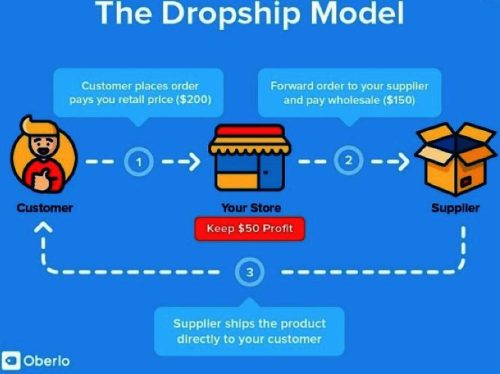
Is drop-shipping the low-risk business model you searching for?
Do the ideas of seamless customer ordering and delivery appeal to your business sense?
So, what is dropshipping? Drop shipping means you take orders on your website, including payment; you then order those goods from your supplier, paying the wholesale price using the money your customer has paid you.
That’s it. Your supplier sends the customers’ purchases directly to them: You never handle a stamp, packaging, or the order.
This flowchart from Oberlo explains how drop shipping works visually.

- Choose Your Niche
Who are your customers? Forget the idea of selling to everyone: You can’t compete with Amazon. However, you can become a god-like leader in a narrow niche where you understand buyers and how they think.
- Buy Your Domain Name
Your domain name must be short, snappy, and available.
Most domain names that match those criteria have already been taken, though you can often buy them if you are prepared to the pay pocket-gouging prices that domain-sitting “investors” demand.
A cheaper alternative is to make up a short word that is not in the dictionary: This means you can brand that word: Think Google, Facebook, and Pinterest.
Your domain name needs to be easy to spell and to say aloud because most people say the site URL to themselves when they are typing it in. Ideally, your domain name should have some meaning to your buyers, but this is rarely possible.
This Entrepreneur.com article contains more advice on selecting your domain title.
- Choose Your Product
Start with a few lines until your online shop is established, which helps to avoid mental burnout while you are creating your drop shipping business.
The perfect product is small, high-value and lightweight. These factors will maximize your markup and minimize postage costs.
You need to be intimately familiar with every product you expect to sell, so order each item for your own use. Handle the goods, take your own photos and write your own unique description of each item. One-off images and product descriptions will help you rank in Google when people search for the products you sell.
- Choose a Supplier
You need to see yourself as a customer will see you. This means you need to know about any delivery delays, customs charges, and packaging issues, and the only way to be confident on these factors is to order the goods from suppliers you are thinking of using.
- Decide Your Mark Up
You will never have a niche entirely to yourself, so you will always be in competition with other drop shippers. Set your operations apart on reliability, customer service, and personality rather than trying to undercut everyone else.
Many shoppers understand the correlation between low prices and poor service and are happy to pay slightly higher prices if you respond to customer concerns quickly.
- Install Shopify
If you want simplicity, then Shopify is the way to go. A basic Shopify account is only $29 per month, which includes all the software, credit card handling and hosting you need to open your e-commerce store.
You can choose how your Shopify store will look because are scores of ‘themes’ to choose from, including many that are free. If you have more complex needs regarding your Shopify store, you can always find good Shopify web designers who can meet all your needs.
- Set Up Support Systems
Customers buy from *you*, not the wholesaler. You will be the person they complain to; you are the person whose reputation is on the line on social media, and you are the one responsible for fixing any issues customers have.
Things WILL go wrong. Tablets will arrive with cracked screens, SD cards will be dead on arrival, and glass bottles will be delivered empty and in one thousand and one slivers. Most complaints will be genuine, but you will always get a few buyers who lie about their purchases not arriving or being non-functional.
The customer is right, even when they are lying because refusing or delaying a refund will impact your reputation. Unhappy buyers will slate you on their social media accounts, and on review sites. Worse, they will demand refunds from their credit card companies, who will hit you with chargeback penalties and could lead to your payment processor closing your account.
- Go Live
You have everything in place, so press the button and let the world into your store. Start guest posting and linking back to your website to help improve its search position. Use social media including Pinterest, Snapchat and Instagram to post pictures of the items you are selling.
Summary
Drop shipping is an attractive business model because of the extremely low investment and the scalability of the model. Sites like Oberlo and Shopify make setting up an online store simple enough for the average twelve-year-old child to do.
Customer service is mostly a matter of attitude and empathizing with customers. Don’t skimp on it because your business depends on it.
Related posts:






